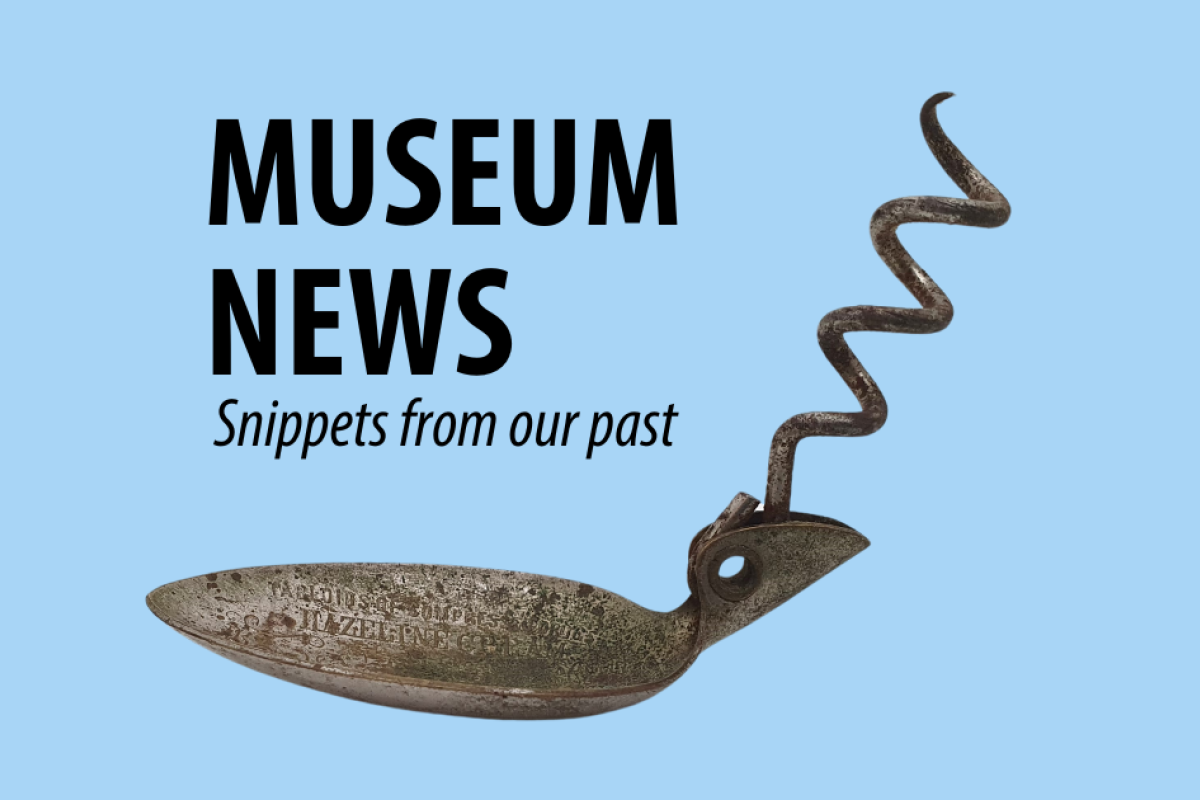Community & Business
6 June, 2025
Museum News - Corkscrew spoon
The story of this rather peculiar spoon, however, starts in 1636, some 400 years ago.


By Leonie Montgomery, museum coordinator
This week’s artefact is another new acquisition, coming in with the collection that was reviewed last fortnight, from John Doherty.
The story of this rather peculiar spoon, however, starts in 1636, some 400 years ago.
An article about the inventor of this corkscrew spoon, written by Ron MacLean, gives a wonderfully detailed account of the evolution of the corkscrew.
Briefly, in 1636 the Wiliemson family sailed from Holland to Long Island, New York in the Americas.
The family flourished over the next two hundred and fifty years, changing the pronunciation and spelling of their name to Williamson in 1761.
In 1876 Cornelius Willamson started a family business manufacturing household goods and advertising novelties. From there, Cornelius entered into a business agreement with William Rockwell Clough in 1877 and formed the company ‘Clough and Williamson’ to manufacture corkscrews.
Corkscrews were apparently very popular as 1878 saw Williamson’s company awarded medals at the International Exhibition in Philadelphia and a silver medal at the Universal Exhibition in Paris.
An editorial in 1882 indicates that C. T. Williamson was a “Manufacturer of Patented Wire Novelties”. The manufacturing plant was driven by steam power and provided steady employment for up to 50 people.
At this time the partnership between Williamson and Clough ended, but Williamson acquired the corkscrew patent rights.
The 1882 Company Catalogue shows the patent diagrams for our artefact. The U.S. Patent was made on September 12, 1882 and the British Patent on October 20, 1892, for a spoon combined with a corkscrew, intended for attachment to a medicine bottle.
The spoon is nickel plated brass, but enthusiastic cleaning has seen much of the nickel removed from our spoon.
The bowl of the spoon is engraved with advertising. “Tabloids of compressed drugs - Hazeline cream - Keplar extract and Essence of Malt - Keplar solution of cod liver oil, Digestive, Demulcent, Strengthening - Hazeline, Beef and Iron Wine”.
According to the ‘Wellcomecollection’ organisation, Hazeline cream was an emollient which “soothes, protects and beautifies the skin” and was also of benefit to “gentlemen who find shaving a painful operation”.
This leads to the question as to why the product would be advertised on an apothecary spoon, made for the taking of medicine? Hazeline cream was first marketed in the 1890s, so the initial US spoons would not have contained this inscription, however, the cream was manufactured by Burroughs Wellcome and Company of London, which does line up with the British patent date.
The Yarrawonga Mercury had an article titled ‘The Kepler Extract of Malt’ in their November 1888 edition.
The article starts “The uses of barley in medicine have been know (known) for 2000 years. Long before the Christian era it was the custom to make barley into a ‘ptisan,’ (this is a type of tea) and thus administer it.
It is a grain richly abundant in the powerful principles that build up tissues and impart strength.
From barley is obtained malt, which is an invaluable food. In manufacturing beer, the maltster allows fermentation to change the important food principles of the barley into alcohol and carbonic acid.
Thus for invalids, beer is of little worth, and often an injury; many malt extracts are made in the same was as beer and should therefore be discarded.
On the other hand, a good malt extract contains all the nutritive elements of the finest barley in a concentrated, preservable state, ever ready for immediate assimilation.
The Kepler Malt Extract contains all these principles – diastase, phosphates, albumenoids, maltose, dextrins and salts.” That dashes anyone’s hopes that a beer a day might keep the doctor away!
The newspaper article continues to outline the wonders of Kepler Malt Extract, giving a little experiment you can perform yourself to prove their point. “The diastase in Malt Extract is a valuable digestive, and prevents indigestion by its action on starch; this action is seen when a spoonful of the Kepler Malt Extract is added to a plate of warm gruel, which it liquefies in a moment.”
The ‘Beef and Iron Wine’ is an iron supplement used for the same purposes as an iron supplement is used today. The Adelaide Jubilee International Exhibition award a Certificate of First Order of Merit for Beef and Iron Wine, Hazeline, in 1887. This exhibition was a celebration of the 50th anniversary of Queen Victoria’s accession to the throne as well as the 50th anniversary of the proclamation of South Australia.
Advertising has always been important in the promotion of new products, but it is a wonder why so many different products were inscribed onto the bowl of this spoon. It would also be interesting to know what type of medicine the spoon was intended to be sold with.
You find this little treasure, along with many other medical relics from the past, upstairs at the Museum in the area dedicated to Nyngan’s early hospital, chemist, Red Cross and home remedies.
Read More: Nyngan